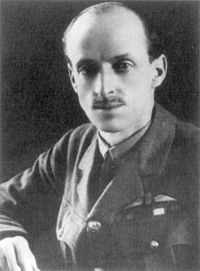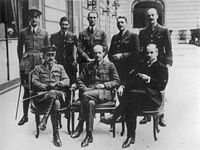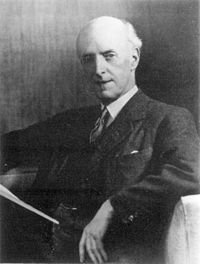Frederick Sykes - Picture
More about World War 1

|
|
Frederick Sykes
Frederick Hugh Sykes
Place of birth: Croydon, England
Allegiance: United Kingdom
Service/branch: Royal Air Force
Rank: Air Vice-Marshal
Commands held: Chief of the Air Staff
Royal Flying Corps
Battles/wars: Second Boer War
World War I
Awards: Knight Grand Commander of the Order of the Star of India
Knight Grand Commander of the Order of the Indian Empire
Knight Grand Cross of the Order of the British Empire
Knight Commander of the Order of the Bath
Companion of the Order of St Michael and St George
Mention in Despatches (2)
Other work: Statesman and Politician
Air Vice-Marshal The Right Honourable Sir Frederick Hugh Sykes GCSI, GCIE, GBE, KCB, CMG (23 July 1877 - 30 September 1954) was a military officer, British statesman and politician.
Sykes was a junior officer in the 15th Hussars before becoming interested in military aviation. He was the first Officer Commanding the Military Wing of the Royal Flying Corps before World War I and later served as the Flying Corps' Chief of Staff in France during the 1914 and 1915. Later in the War, he served in the Royal Naval Air Service in the Eastern Mediterranean before returning to Great Britain where he worked to organise the Machine Gun Corps and manpower planning. In late 1917 and early 1918, Sykes was the deputy to General Wilson on the Supreme War Council and from April 1918 to early 1919 he served as the second Chief of the Air Staff.
After the War, Sykes was appointed the Controller of Civil Aviation and he continued in this role until 1922 when he entered politics, becoming the Conservative MP for Sheffield Hallam, which he held until 1928 when he resigned. From 1928 to 1931 Sykes was Governor of Bombay, after which time he returned to Great Britain where he involved himself in business and public life. During World War II, Sykes was an MP once more, this time for Central Nottingham. He lost his seat in 1945 and he died nine years later.
Military career
Following civilian employment as a clerk and after working on a tea plantation in Ceylon, Sykes enlisted as a trooper in the Imperial Yeomanry Scouts regiment of the British Army at the start of the Boer War. Following capture, Sykes was forcibly marched across South Africa but was later abandoned and returned to the British forces. In 1900 he was commissioned into Lord Roberts' Bodyguard but suffered a serious wound to the chest which resulted in his being invalided back to Great Britain. On 2 October 1901 he was granted a regular commission as a 2nd lieutenant in the 15th Hussars. In the following years, Sykes served in India and, for a short time, in West Africa.
In 1904, Sykes's interest in aviation was first demonstrated when he obtained his ballooning certificate whilst being attached to the Balloon Section of the Royal Engineers. In 1910 Sykes commenced flying lessons at Brooklands which led to him being awarded Royal Aero Club certificate No. 96 in June 1911.
In February 1911, Sykes was posted as a staff officer to the Directorate of Military Operations at the War Office. As a firm believer in the importance of wartime aerial reconnaissance, he was chosen to join the sub-committee of the Committee of Imperial Defence which was given the task of investigating the use of aircraft. Brigadier-General Henderson and Major McInness also served on the same sub-committee and their recommendations (given in 1912) were accepted by the Committee of Imperial Defence and resulted in the formation of the Royal Flying Corps.
On 13 May 1912 Sykes was appointed Officer Commanding the Military Wing of the Royal Flying Corps. His duties included the recruitment and training of pilots. Whilst in command, Sykes solicited suggestions for a new motto for the Corps. Sykes approved J S Yule's suggestion, Per Ardua ad Astra, and it was this phrase which was subsequently adopted by the Royal Air Force as its motto.

Picture - Sir Frederick Sykes
With the outbreak of World War I, Royal Flying Corps squadrons were deployed to France in August 1914. Although the configuration and effectiveness of the deployed forces owed much to Sykes, as a middle-ranking officer he lacked the seniority thought necessary for command in the field. General Sir David Henderson became the General Officer Commanding the Royal Flying Corps in the Field and Sykes acted as his Chief of Staff.
On 22 November 1914, Henderson was appointed General Officer Commanding the 1st Infantry Division and Sykes took up command of the Royal Flying Corps in the Field. However, Sykes did not spend long in command. The decision to post Henderson and replace him with Sykes was not to Lord Kitchener's liking and he ordered a reversal of the appointments. On 20 December 1914, Henderson resumed command of the Royal Flying Corps in the Field and Sykes was once again his Chief of Staff.
With the rapid expansion of the Corps, there was a growing debate between those who believed that the Corps should remain under central control and those who believed that its units should be placed under the control of the corps or divisional commanders. Unsurprisingly as Chief of Staff, Sykes took the former view and following increasing arguments, Sykes was posted on 26 May 1915 being placed at the disposal of the Admiralty.
Sykes visited the Dardanelles to investigate the confused air situation and after writing a report he was appointed as the Officer Commanding the Royal Naval Air Service Eastern Mediterranean Station with the naval rank of captain, having briefly been appointed Colonel Commandant in the Royal Marines. This made Sykes the air commander for the Dardanelles Campaign. During this time he acted on the recommendations of his report, building up his forces which sunk several Turkish ships.
In March 1916 Sykes he was made Assistant Adjutant and Quartermaster-General of the 4th Mounted Division and in June 1916 he was appointed Assistant Adjutant-General at the War Office with responsibility for organising the Machine Gun Corps and manpower planning. In late 1917 he served on the British section of the Allied War Council in Versailles under General Wilson.
Sykes's military career culminated in his appointment as Chief of the Air Staff from 13 April 1918 to 1 January 1919 when he retired with the rank of Major General. He was granted the equivalent rank of Air Vice Marshal when the RAF introduced its own rank structure in August 1919.

Picture - The British Air Section at the Paris Peace Conference in 1919
In February 1919, Sykes led the British Air Section at the Paris Peace Conference in Versailles.
From 1919 to 1922, Sykes was the Controller of Civil Aviation. He retired from the RAF on 1 April 1919 some months after becoming the Controller-General of Civil Aviation. In 1922 he published Aviation in War and Peace, a history of aviation in three chapters which covered pre-War flight, aviation during World War I and both military and civil aviation in peace time.
Political career

Picture - Sir Frederick Sykes
In 1922, Sykes entered public political life and at the 1922 general election in November he was elected as Member of Parliament (MP) for Sheffield Hallam from 1922, representing the Conservative Party. Sykes retained the seat at the 1924 election. He resigned the seat on 26 June 1928 to take up an appointment as Governor of Bombay on 8 December 1928, serving in this post until 25 April 1931.
Sykes returned to Great Britain in 1933 and for the next six years he held various directorships and official committees posts. With the outbreak of War in 1939 Sykes offered his services to the British Government but he was not required and so he stood for Parliament once more. Ater the death in May 1940 of Terence O'Connor, the Solicitor General and MP for Nottingham Central, Sykes was returned unopposed in the resulting by-election. He served as Nottingham Central MP until the 1945 general election, when the seat was won for Labour by Geoffrey de Freitas.
Family life
Frederick Sykes's father was Henry Sykes of Addiscombe in London and he was a nephew of Godfrey Sykes. Frederick Sykes was born in Croydon and married Isabel H. Law, the daughter of Conservative Prime Minister Andrew Bonar Law in 1920. Their son Bonar Sykes (1922-1998) was an officer in the Royal Navy during World War II who was present at the D-Day landings, and subsequently a member of the diplomatic corps, a farmer and High Sheriff of Wiltshire who married Mary, daughter of ambassador Sir Eric Phipps; they had four sons: Hugh Sykes, David Sykes, James Sykes and Alan Sykes. Hugh went on to have one son Nicholas Sykes (17/11/84). James had one son, William Mostyn Bonar Sykes (11/07/88) and one daughter, Catherine Elizabeth Mary Sykes (17/08/90). Alan had one son, Samuel Sykes (04/05/92).
Honours and awards
Privy Councillor - 1928 Knight Grand Commander of the Order of the Star of India - 1934 Knight Grand Commander of the Order of the Indian Empire - 3 November 1928 Knight Grand Cross of the Order of the British Empire - 1919 Knight Commander of the Order of the Bath - 1 January 1919 Companion of the Order of St Michael and St George - 14 March 1916 Mentioned in Despatches - 19 October 1914, 14 March 1916 Knight of Justice of the Order of St John - 1936 Order of St Vladimir, 4th Class (Russia) - 12 April 1916 Order of Leopold, Commander (Belgium) - 15 July 1919 Distinguished Service Medal (United States) - 15 July 1919 Legion of Honour, Croix de Commandeur (France) - 18 November 1919 Order of the Rising Sun, 2nd Class (Japan) - 4 January 1921
Ash, Eric (1999). Sir Frederick Sykes and the air revolution, 1912-1918. Publisher: London ; Portland, OR : Frank Cass. ISBN 0-7146-4828-0 (cloth) ISBN 0-7146-4382-3 (paperback)
Pathé news video of Sir Frederick Sykes as Governor of Bombay
Probert, H. (1991). High Commanders of the Royal Air Force. HMSO. ISBN 0-11-772635-4
Sykes, Major-General the Right Hon Sir Frederick (1942) From Many Angles: an autobiography. Publisher: Harrap, London
More aircraft.
Source: WikiPedia